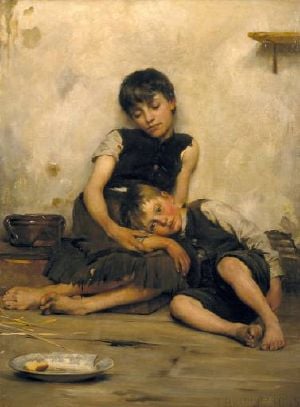Orphanage
 From Nwe
From Nwe 
An orphanage is an institution dedicated to caring for children who have lost their parents, or for children believed to be abused, abandoned, or generally neglected. Largely seen as an inferior alternative to foster care and adoption, orphanages may be privately or publicly funded, or may be run by religious organizations. An orphan is a person, typically a child, who has lost both parents. Historically, certain birth parents were often pressured or forced to give up their children to orphanages, such as children born out of wedlock or into poor families. An obligation of support is often imposed upon parents or grandparents under nearly every system of law; however natural sympathy and a willingness to support the common good often allow for the care of orphans to become a public duty.
At the beginning of the twenty-first century more than 200 million orphans were reported throughout the world; this number includes all children internally displaced, refugees of conflicts and natural disasters, mandated child soldiers, those enrolled in orphanage institutions, and those estimated to be homeless, living on the streets. While efforts to improve the conditions in orphanages are important, the greater effort has moved to finding stable homes for children in such situations, where they may have the chance to experience the love of family despite their tragic past.
History

In Biblical times, small communities were deemed responsible for the care of the fatherless, the stranger, and the widow by sharing with them the excess fruits of their harvests. Under early Roman law, no provisions were made for either widow or orphan, though early Athenians viewed such duties as economic and patriotic; the state educated all children of citizens killed in battle until the age of 18.
Christian missionaries established various relief agencies for the care of orphaned or abandoned children; workers founded children’s hospitals and asylums throughout the East. Under Justinian, the care of orphans was directed toward the Church. It became the duty of various church officials to raise, educate, and establish orphaned children both of the male and female sex.
During the Middle Ages, the care of orphaned children became the responsibility of monasteries. Under monastery care, orphaned children were provided with both shelter and education in academics and trades. Many orphanages practiced some form of "binding-out" in which children, as soon as they were old enough, were given as apprentices to households. This would ensure both their financial support and their learning of a useful trade.
Throughout Great Britain, between the years of 1855 and 1898, more than fifty-one houses of Sisters of Charity were established to serve the orphan population of Northern Europe. Under subsequent English Poor Laws, the care of poor, abandoned, or orphaned children remained the responsibility of the Church; parishes relied on systems of apprenticeship, indentured service, or workhouses to aid in the influx of homeless children and their growing dependence on the state. The exposure of such systems by early social reformers and artists as brutal boarding establishments led to drastic reforms of Britain’s social welfare system. Under Queen Victoria, numerous private orphanage asylums were created that maintained significantly improved conditions.
In Colonial America, poor, abandoned, or orphaned children became the responsibility of the local town or county. This responsibility was later shifted to almshouses, establishments created solely for the care of society’s unfortunate. The colonies also made significant use of indentured services. In 1875, the state of New York began placing poor, abandoned, or orphaned children into the custody of established families or newly opened orphan asylums. Over time, this system of social care would develop and expand, eventually shaping the institutional orphanages that are relied upon today.
Operations

The effective management of orphanage institutions requires innovative solutions to many complex problems that arise from a child’s abandonment or desertion. In many instances, orphaned children are regularly assessed both physically and mentally in order to gauge their progress in social adaptation. Successful orphanages aim to provide adequate goods and services to their inhabitants; often times orphanages provide both education and healthcare for the children. In most circumstances, institutional buildings must be safe and well equipped with adequate sanitation, and must provide a social environment thoroughly conducive to health.
Many orphanages follow similar methodologies in the effective upbringing of orphaned children. One common method employed by many orphanages is to create or emplace orphaned children with an environment of “family life.” This can be accomplished by “boarding-out,” or “placing-out.” The boarding-out of an orphaned child involves the payment of the orphanage institution to a family who has agreed to house the orphaned child or children for a temporary period of time. Such tactics originated under English Poor Law and were designed as an alternative option to enrollment in a poorhouse. A major weakness to the boarding-out methodology is the monetary incentive it poses; orphanages often face the danger of profit-seeking amongst those offering to care for an orphaned child.
In contrast, the placing-out of an orphaned child is generally agreed to provide a more permanent and effective environment of family life than the former option. Under placing-out practices, an orphaned child or group of children is placed into an established home without any form of compensation. Similar to adoption tactics, the orphaned child is given a more permanent sense of home, a more effective environment in which to develop, and more similar surroundings to a standard family group. Under many placing-out experiences, the orphaned child and participating family group often foster a sense of affection and general maturation, and equally gain as much from the charitable experience.
Many psychological studies surround the operations and effectiveness of orphanage institutions. For example, John Bowlby's attachment theory, provides both a descriptive and explanatory framework for the discussion of affectionate relationships between human beings. Bowlby’s work stresses the attitudes and behaviors of young children toward their adult caregivers, both blood related and not. Attachment theory focuses on the emotional experiences that motivate one’s behavior, and one’s cognitive and memory functions. It provides unique insight into the effectiveness of orphanage operations, boarding-out methodologies, and placing-out tactics.
Orphanages around the World

According to the United Nations Children's Fund (UNICEF), there exist more than 210 million orphans throughout the world. Of these orphaned children, more than 86 million orphans are living in India, more than 10 million orphans are living throughout Mexico, more than 3.5 million orphaned children exist throughout Asia, and more than 5.5 orphaned children are presently living in Africa. The number of orphaned children in Africa is expected to rise to more than 44 million by the year 2010 as a direct result of the widespread HIV/AIDS epidemic. Other statistics show more than 1.5 million orphans living throughout Eastern Europe, nearly 400,000 orphans living throughout Latin America, and more than 135,000 orphaned children enrolled within the U.S. foster care system. As a direct result of these numbers, more than 35,000 children die each day due to hunger and malnutrition.
China
In 2003, the Chinese World News estimated there to be more than 100,000 children housed in orphanages throughout China. However, significant debate remains regarding the actual number of homeless children in China, with various human rights agencies believing that this official number of Chinese orphans is alarmingly low. It has been suggested that this report failed to account for most of the country’s abandoned children and infants living without state funding, and acknowledged only the minor portion of orphaned children enrolled in state care. As of 2005, UNICEF estimated China to hold more than 20 million orphaned children throughout the nation.
Iraq
According to UNICEF, the number of orphans throughout Iraq remains around 2,000. In 1990, Iraq housed more than twenty-five state homes for the care of orphaned children; this number has steadily declined in more recent years. In 1999 UNICEF recommended the significant rebuilding of state-run facilities to house the national capacity of orphans.
Romania
The epidemic of orphaned children throughout Romania originally began in 1965. Under Communist dictator Nicolae Ceaucescu, Romania’s population was organized to swell to nearly 30 million. Ceaucescu, aiming to increase military power in numbers, employed drastic measures to increase the country’s birth rate; by law, each Romanian woman was required to have at least four children, birth control was outlawed until the age of 45, and families with less than three children were heavily taxed. Ceaucescu’s oppressive regime created a boom of unwanted children that further destroyed the unstable Romanian economy. Such conditions led to a rapid increase in the number of abandoned Romanian children, a problem that remains prevalent throughout Romania.[1]
Russia

According to a 2003 study by the Russian Health Ministry, there exist more than 700,000 orphaned children and teenagers living throughout Russia in state-run institutions. More than 15,000 orphans graduate from these programs each year; 40 percent of all graduates frequent Russian prisons, and an average of 10 percent are believed to commit suicide. [2]
Rwanda
According to the African Region Human Development Series, in recent years there existed more than 400,000 orphans in Rwanda of which only 5,000 received state care. With the spread of AIDS, UNICEF has estimated the actual number of orphaned children throughout Rwanda to be more than 800,000.[3]
Sri Lanka
According to a 2005 study, more than 4,500 Sri Lankan orphans exist in various types of state-funded services. The majority of these orphans lost one or more parent in the December 2004 tsunami that overcame the Indonesian islands. Various foreign aid groups are still working to fund and establish orphanage institutions in order to remove the young victims from temporary refugee camps. International aid is continually donated.
Adoption
In more recent years, adoption has emerged as an effective alternative to orphanage institutions. Adoption, or the legal creation of a relationship defining parent and child, was originally recognized by Roman law. In the United States, the practice was first introduced in the mid-nineteenth century. Most legal adoptions require a hearing before a judge in which the relationship between adoptive parent and adopted child is legally ratified. Consent must be given by all parties including the birth parents or temporary guardians. After adoption, children generally assume the same rights and duties of a natural child, while adoptive parents assume the right of custody and the obligation of support for the child.
Under many circumstances, children are adopted by relatives. Other adoptive parents may include married couples, unmarried adults, or homosexual couples. Though most adoptions seek to match a child’s race to that of an adoptive parent, transracial adoptions are becoming increasingly prevalent as the supply of orphaned children significantly outweighs the demand to adopt in the US.
Many psychologists believe adoption to be a superior alternative to orphanage institutions. Various studies have shown adoption to create a more permanent and secure environment in which an orphaned child may develop and mature. Despite these advantages, both orphanage institutions and adoptive processes are in continual existence; worldwide, the overwhelming number of children without homes requires that both alternatives be relied upon.
Orphans in Literature

Orphaned characters are common as literary protagonists, especially in children's and fantasy literature. The lack of parents leaves the characters to pursue more interesting and adventurous lives, by freeing them from familial obligations and controls, and depriving them of more prosaic lives. It creates characters that are self-contained and introspective and who strive for affection. Orphans can metaphorically search for self-understanding through attempting to know their roots. Parents can also be allies and sources of aid for children; removing the parents makes the character's difficulties more severe. Parents, furthermore, can be irrelevant to the theme a writer is trying to develop, and orphaning the character frees the writer from the necessity to depict such an irrelevant relationship. All these characteristics make orphans attractive characters for authors.
One recurring storyline has been the relationship that the orphan can have with an adult from outside his or her immediate family. Some of the most emotive works have been those featuring the relationship between a man and a boy, particularly boys that are coming of age. A number of well known authors have written books featuring orphans, including Charles Dickens, Mark Twain, Louisa May Alcott, Roald Dahl, and J.K. Rowling. In many works of fiction, notably Charles Dickens’ Oliver Twist and Harold Gray’s Little Orphan Annie, the administrators of orphanages are depicted as cruel monsters.
Orphanages Today
Since the 1950s, the United States and other countries have moved to de-institutionalize the care of vulnerable children—that is, close down orphanages in favor of foster care and accelerated adoption. Moreover, as it is no longer common for birth parents in Western countries to give up their children without placing them for adoption, the need to operate large orphanages has decreased. These factors have also resulted in a dramatic reduction of local orphans available for adoption in first-world countries, necessitating journeys by many would-be adoptive parents to orphanages in the Third World.
Today, the orphanage remains common and necessary in most parts of the world, even if the term has given way to such softer language as "group home," "children's home," or "rehabilitation center." Such institutions are not common in the European community, and Romania in particular has struggled to reduce the visibility of its children's institutions to meet conditions of its entry into the European Union. In the United States, the largest remaining orphanage is the Bethesda Orphanage, founded in 1740 by George Whitefield. Another famous American orphanage is Girls and Boys Town, located outside of Omaha, Nebraska.
Orphan Charities
Prior to the establishment of state care for orphans in First World countries, many private charities existed to take care of destitute orphans.
- SOS Children's Villages is the world's largest non-governmental, non-denominational child welfare organization. Its mission is to provide stable homes and loving families for orphaned and abandoned children around the world.
- Dr Barnardo's Homes Identity Foundation provides education, medical aid, and counseling to all deprived children in Pune, India. The foundation engages in the placement in shelters for orphans and runaways, reintegration of runaways with their family and identification of foster families willing to adopt or support such children.
- Orphan Rights is dedicated to providing orphans with food, shelter, clothing, and parental care.
- Brother Brother Sister Sister is a nonprofit organization founded in 2004 to help AIDS orphans in Zimbabwe, the Sub-Saharan African country where nearly 1 million AIDS orphans struggle to survive.
- Florida Baptist Children's Homes provides out-of-home care for Florida children.
- iCOR ORPHANS, or the International City of Refuge, brings God's love, hope and healing to children in need. iCOR Orphans is committed to establishing Christ-centered orphanages and shelters around the world making an impact for future generations.
Notes
- ↑ House of Angels Why are there so many Abandoned Children in Romania? Retrieved September 17, 2007.
- ↑ Ascent Russian Orphan Aid Organization Orphan Facts and Statistics Retrieved September 17, 2007.
- ↑ K. Subbarao, Angel Mattimore, and Kathrin Plangemann, “Social Protection of Africa’s Orphans and Other Vulnerable Children.” African Region Human Development Working Series Paper. Retrieved September 17, 2007.
References
ISBN links support NWE through referral fees
- Askeland, Lori. 2005. Children and Youth in Adoption, Orphanages, and Foster Care: A Historical Handbook and Guide. Westport, CT: Greenwood Press. ISBN 0313331839
- McKenzie, Richard. 1998. Rethinking Orphanages for the 21st Century. London: Sage Publications. ISBN 0761914447
- Reef, Catherine. 2005. Alone in the World: Orphans and Orphanages in America. Boston: Clarion Books. ISBN 0618356703
- 1911. The Catholic Encyclopedia, Volume XI. New York: Robert Appleton Company.
- Adoption Britannica Concise Encyclopedia. Retrieved September 4, 2007.
- Adoption The Healing Place Church. Retrieved September 4, 2007.
- About the Need Mission One Orphan Agency. Retrieved September 4, 2007.
External Links
All links retrieved November 17, 2022.
- Orphans and Orphanages Catholic Encyclopedia.
Credits
New World Encyclopedia writers and editors rewrote and completed the Wikipedia article in accordance with New World Encyclopedia standards. This article abides by terms of the Creative Commons CC-by-sa 3.0 License (CC-by-sa), which may be used and disseminated with proper attribution. Credit is due under the terms of this license that can reference both the New World Encyclopedia contributors and the selfless volunteer contributors of the Wikimedia Foundation. To cite this article click here for a list of acceptable citing formats.The history of earlier contributions by wikipedians is accessible to researchers here:
- Orphanage history
- Orphan history
The history of this article since it was imported to New World Encyclopedia:
- History of "Orphanage"
Note: Some restrictions may apply to use of individual images which are separately licensed.
↧ Download as ZWI file | Last modified: 02/03/2023 21:26:12 | 66 views
☰ Source: https://www.newworldencyclopedia.org/entry/Orphanage | License: CC BY-SA 3.0
 ZWI signed:
ZWI signed: KSF
KSF